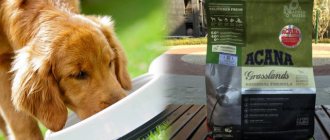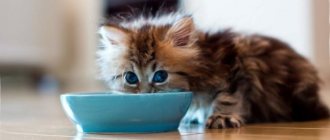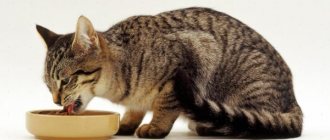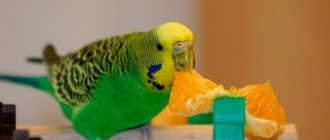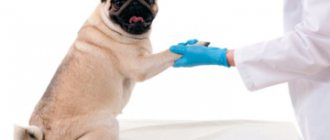First food for a small dog
Pug litters are rarely large, with an average of 2 to 5 puppies born. This amount is optimal for natural feeding. However, in some circumstances, for example when the bitch has little milk and the puppies are not gaining weight well, it is recommended to introduce early complementary foods.
An objective signal for the decision to introduce complementary foods is a log of the puppies' weight gain. If there is no weight gain within 3 days, the puppies behave restlessly, squeak and pick at their nipples - it is necessary to introduce additional nutrition. Before 3 weeks of age, they cannot digest meat or processed food.
How to do it right?
Cow's milk, due to its high lactose content, is also poorly digestible. The best option would be to use a specialized milk formula. It is diluted in the proportions specified in the instructions, usually 30 ml of water per 1 measuring spoon, and heated to 36 degrees.
Milk is given through special bottles, or poured into a syringe with the needle removed. If necessary, such a substitute can be given from the first day.
What can be given to adult dogs of this breed?
For those who prefer to feed their dog natural food, you need to know what a pug can eat and what will not harm it. A very large number of dog owners believe that if they feed them the same food that people eat, nothing will happen.
This opinion is a big misconception, since such nutrition can cause the development of various diseases in the pet. So what should you feed representatives of this breed? The diet of a pug eating natural food should contain the following products:
- Half of the diet is meat product. Veterinarians believe that it is best to give pugs lamb, rabbit or chicken with a small amount of fat. The amount of meat should be 20 grams for every kilogram of the dog’s weight.
- Be sure to give your four-legged family member porridge (buckwheat, rice or oatmeal). The amount of porridge in the diet should be at least 25%.
- 20% are products of dairy origin, but it is important to take into account that pure milk is poorly absorbed by the pug’s body, and it is not necessary to give it. It is better if it is kefir, yogurt, cottage cheese.
- Fresh and boiled fruits and vegetables. It is best to give your pug cucumbers, peppers, beets and cabbage. But not all pugs love fruit, so you can’t give them very often.
- Fish should also be included in the diet, but not raw or with missing bones.
There is no need to give milk and meat products at the same time; this can cause stomach and digestive problems in your pet. You can mix porridge and meat product or vegetables and grains.
How many times a day is it possible?
Immediately after birth, puppies eat very often. The rest of the time they sleep. If the litter is entirely bottle-fed, there are two feeding plans for pug puppies.
In the “on demand” mode, the mixture is given at the moment when the puppies begin to behave restlessly. However, this regime is extremely difficult for the breeder, due to the uneven load throughout the day.
It is much more productive to use the “time-based” mode. In the first week, puppies need to be fed every 2 hours during the day and about 3 times at night. For example, starting in the morning at 6, at 8, 10, 12, 14, 16, 18, 20, and then at 23, 2 in the morning, 4 in the morning. At the rate of ½ teaspoon of dry mixture per puppy per feeding.
Feeding a pug puppy from three months
At the age of three months, a pug puppy begins to grow rapidly. It lasts until 7 months, when the puppy reaches the size of an adult animal. Further, the growth of the animal slows down and continues with a small annual increase until the age of 1.5 years.
During this period, the owner must provide good nutrition to his pet - balanced and in sufficient quantities. It is during this period that the puppy can eat a portion that is 1.5-2 times larger than that of an adult pug, but this should not confuse the owner. Energy consumption for growth in puppies is significantly higher than any physical activity of an adult dog. At the age of 3 months, the puppy must be provided with 4 full meals a day.
An approximate menu for a small pug at that age consists of the following products: for the first and second feedings, the baby is offered kefir, yogurt or milk; honey and raw quail eggs can still be added to the mixture; it is very good to give the baby cottage cheese or low-fat varieties of cheese to prevent rickets. Vegetables can be given in any form - raw, boiled or stewed. At this age, puppies can add black bread with butter and cheese, cut into slices, to their portion. Puppies are given porridge cooked from any cereal, with the exception of semolina, raw fruits, dried fruits, crushed cloves of garlic, which disinfect the intestinal mucosa well. Several times a week, the puppy is offered boiled fish and even slices of salted herring.
The third and fourth feedings daily consist of raw meat. The bones in the meat should be beaten well with a hammer, and the puppy should eat them. Raw bones are well digested in the dog’s stomach, while boiled ones simply spread apart but do not dissolve. The puppy must be fed lean varieties of meat - beef, veal, lamb, chicken, rabbit, turkey. Pork is contraindicated for puppies. Lamb is best for pugs. If you feed a bird, then its legs, wings and necks must be cut off and given to the puppy. At this age, regurgitation is quite acceptable - everything that the puppy’s stomach cannot digest, he regurgitates.
In small courses, it is recommended to add the drug “Eniferm” to the puppy’s diet, which helps create normal microflora in the puppy’s stomach and intestines. This will help the puppy transition painlessly to solid food and protect against many diseases.
From the age of 5 months, the puppy is transferred to 3 meals a day, keeping dairy products, cereals and raw meat in the diet. The pug's food must be solid, otherwise his back will begin to sag. The puppy must be fed until it is full.
After seven months, the puppy switches to the diet of an adult dog - morning and evening or afternoon and evening. In the first half of the day he is fed porridge and dairy products, and in the second - raw meat and vegetables.
What do they eat at 2 weeks of age?
By the second week of life, puppies' needs for formula increase, but they still cannot digest lactose. Therefore, it is optimal to continue using bitch milk substitutes.
For example:
- Bosch Puppy Milk milk replacer for dogs;
- Royal Canin Babydog Milk;
- Canina Welpenmilch and others.
The amount of the finished mixture is doubled. The feeding regimen remains the same.
In cases where it is not possible to use a ready-made mixture, it is possible to use heated goat’s milk with a quail egg yolk added to it. The need to add an egg is explained by the fact that bitch milk has a much higher percentage of fat content than goat milk.
Nutrition for a 3 week old
In the third week, the daily dosage for a pug puppy increases to 1 ½ teaspoons of dry mixture. Feeding occurs at intervals of 2-3 hours, a total of 8 times per day. By the end of the week, you can introduce the first meat supplement.
To do this, take lean meat, such as veal or turkey. Raw meat is ground in a blender until pureed and given to the puppies. For the first time, the volume of the meat ball should be no larger than a bean. Gradually the size increases to half a tennis ball.
Prohibited Products
Let's talk about what you should not feed your pug. Due to the sensitive digestion of representatives of this breed, there are a number of foods whose consumption is unacceptable.
These include:
- Pasta
- Semolina porridge, especially in combination with gravy
- Potato
- Sugar and sugar-containing products
- Pastries and bread
- Smoked meats, pickles and semi-finished products.
The listed products cause digestive disorders, and subsequently lead to chronic diseases.
Diet for 1 month
At week 4, the daily volume is 3 teaspoons of dry mixture per 1 pug puppy. Feeding intervals are maintained, the total amount also reaches up to 8 times. Gradually, one feeding with formula is completely replaced with meat.
The pug is a breed prone to allergies, so the introduction of any new products should begin with small portions and with mandatory monitoring of the reaction.
You can often find a recommendation to give soaked dry food as the first complementary food. However, puppies most often are not interested in it, since they get enough nutrients from bitches’ milk. Unlike dry food, meat almost always arouses keen interest.
Also during this period you can introduce homemade cottage cheese .
For this purpose, 3.2% milk is taken. Kefir has the same fat content – 3.2%. Half a liter of milk is poured into the pan, then you need to heat it until hot and add kefir (also half a liter).
Reduce the heat to low and watch when curds begin to form on the surface, and yellow-greenish whey underneath.
Turn off the heat and let stand for a while. Homemade cottage cheese is ready!
When the cottage cheese has cooled, give it to the puppies. The dogs happily drink the remaining whey.
The proportions milk/kefir are approximately 1/1. You can use a little more milk than kefir.
After 2-3 days from the beginning of introducing the product into the diet, in the absence of negative reactions, one feeding with the mixture is completely replaced with cottage cheese.
Dry food
His choice depends on the age and individual characteristics of the animal. There are the following types:
- The most common is dry food. It contains only natural ingredients and nutrients; before feeding, it is necessary to mix the product with hot water or milk, cool, and only then give it to the animal.
- Wet food made from partially water-free kibble that replaces meat. By eating this food, the dog will not receive the required amount of vitamins, minerals and nutrients;
- Canned food, which is a mixture of porridge and meat.
- Biscuit crumbs are quite suitable for puppies; they perfectly compensate for the lack of carbohydrates; moreover, they can be mixed with minced meat or fish, or with vegetables.
- It is recommended to give young pugs dog biscuits, which promotes the development of chewing muscles.
- Canned food from various types of meat, which meets the needs of animals for various substances, contains products of animal and plant origin.
- Food in the form of flakes that dissolve in milk or water.
Have you asked, have you asked what to feed your Chihuahua? All about dog nutrition in our article.
Did you know that the main characteristic of the Chihuahua breed is its fighting spirit. Read more about the little pranksters.
Whichever type you choose from the above, be sure to monitor the amount of water your animal drinks. Vary your pug's diet and create a different feeding plan for each week.
Regime after 6 and up to a year
From six months, puppies no longer need as high-calorie food as before. Most manufacturers of ready-made complete food produce special lines specifically for this age. The number of feedings per day should be at least 3 times a day. The daily portion is not given at once, but is divided into 3 parts.
Pugs, having a good appetite, cannot stop in time, so they often overeat. It is recommended to maintain the volumes specified by the food manufacturer on the packaging, in proportion to the weight and age of the puppy.
General nutrition rules
- Feed your dog at the same time every day.
- If the puppy is 1 month old, then it needs to be fed up to 6 times a day, from 2 to 4 months - 4 times, from 4 to 6 months - 3 times, and from six months the dog needs to be fed no more than 2 times a day.
- Food should not be hot or frozen.
- In the morning, give cottage cheese, fruits, vegetables, porridge and greens. In the evening - meat or fish.
- Do not mix dry food with natural food.
- Do not buy loose food; it may be stored in improper conditions, and it is almost impossible to control the expiration date.
- Your pug should always have a bowl of fresh water.
- Don't feed your dog from the table.
- When choosing dry food, read its composition.
If you follow all the rules, your pet will be healthy and will give you only joy!
